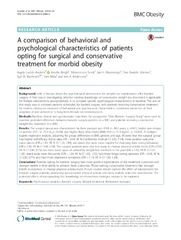A comparison of behavioral and psychological characteristics of patients opting for surgical and conservative treatment for morbid obesity
Permanent lenke
https://hdl.handle.net/10037/8480Dato
2016-02-05Type
Journal articleTidsskriftartikkel
Peer reviewed
Forfatter
Kvalem, Ingela Lundin; Bergh, Irmelin; von Soest, Tilmann; Rosenvinge, Jan H; Johnsen, Tina Avantis; Martinsen, Egil Wilhelm; Mala, Tom; Kristinsson, Jon AdalsteinnSammendrag
Background
Little is known about the psychological prerequisites for weight loss maintenance after bariatric surgery. A first step in investigating whether existing knowledge of conservative weight loss treatment is applicable for lifestyle interventions postoperatively is to compare specific psychological characteristics at baseline. The aim of this study was to compare patients scheduled for bariatric surgery with patients receiving conservative treatment for morbid obesity on measures of behavioral and psychosocial characteristics considered predictors of their adoption of and adherence to long-term lifestyle recommendations.
Methods
Baseline clinical and questionnaire data from the prospective “Oslo Bariatric Surgery Study” were used to examine potential differences between bariatric surgery patients (n = 301) and patients receiving conservative weight loss treatment (n = 261).
Results
The surgical group was characterized by their younger age (43.8 vs. 46.2 years, p <0.01), higher percentage of women (79.1 vs. 70.1 %, p <0.05), and higher Body Mass Index (BMI; 45.0 vs. 41.9 kg/m2, p <0.001). A multiple logistic regression analysis, adjusting for group differences in BMI, gender, and age, showed that the surgical group had higher self-efficacy (Odds ratio; OR = 3.44, 95 % Confidence interval; CI 1.65, 7.14), more positive outcome expectations (OR = 1.53, 95 % CI 1.23, 1.89), and plans that were more explicit for changing their eating behaviors (OR = 1.80, 95 % CI 1.06, 1.93). The surgical patients were also less ready to change physical activity levels (OR = 0.59, 95 % CI 0.48, 0.73), had tried more types of unhealthy weight loss methods in the past (OR = 1.16, 95 % CI 1.01, 1.33), drank soda more frequently (OR = 1.24, 95 % CI 1.02, 1.50), had fewer binge eating episodes (OR = 0.38, 95 % CI 0.20, 0.71), and had more depressive symptoms (OR = 1.19, 95 % CI 1.09, 1.29).
Conclusions
Patients opting for bariatric surgery had more positive expectations of the treatment outcomes and stronger beliefs in their ability to achieve these outcomes. Those starting conservative treatment had stronger beliefs in readiness to change physical activity levels. Future studies should explore the effect of interventions for bariatric surgery patients, promoting postoperative physical activity and stress realistic outcome expectations. The potential effects of incorporating this knowledge in intervention strategies remain to be explored.


 English
English norsk
norsk